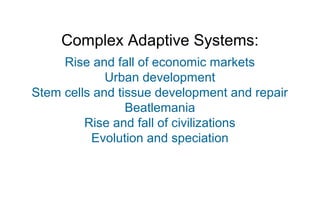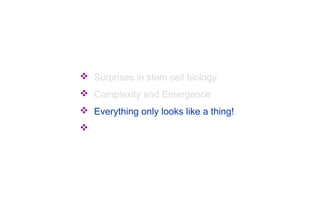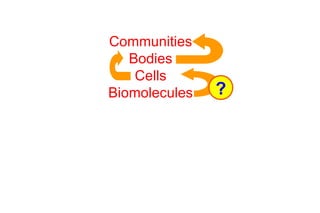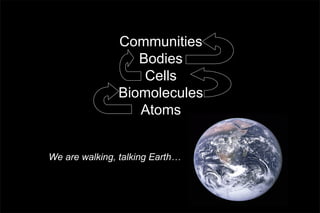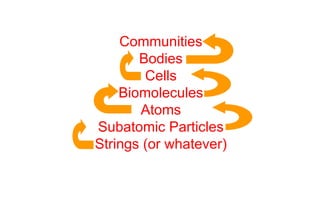Stem Cells, Complexity, and the Science of Being
- 1. Icahn School of Medicine at Mount Sinai Neil Theise, MD Department of Pathology New York University School of Medicine New York City Stem Cells, Complexity and the Science of Being
- 2. “Thinking is better than knowing, but looking is even better.” Goethe, “Maxims”
- 3. Goethe, “Maxims” “Thinking is better than knowing, but looking is even better.”
- 4. Surprises in stem cell biology Complexity and Emergence Everything only looks like a thing! What/who are we…?
- 5. Surprises in stem cell biology Complexity and Emergence Everything only looks like a thing! What/who are we…?
- 8. LethalLethal IrradiationIrradiation Male bone marrow transplantMale bone marrow transplant F.I.S.H.F.I.S.H. forfor Y-ChromosomeY-Chromosome
- 10. The Standard Paradigm: Restricted Cell Plasticity
- 11. Irreversible gene restrictions Embryology & Adult Tissue Reconstitution Self renewal
- 12. BEWARE OF DOGMA
- 14. Embryonic Stem Cells All three layers of the embryo: Mesoderm, Endoderm, Ectoderm
- 15. Embryonic Stem Cells All three layers of the embryo: Mesoderm: muscle, blood, bone Endoderm: visceral organs Ectoderm: brain, nerves, skin so….
- 16. Embryonic Stem Cells Can make everything!
- 17. Embryonic Stem Cells Can make everything, in order to: perform cell transplants… create artificial organs (livers!) implant genes for gene therapies…
- 18. Embryonic Stem Cells Can make everything! Adult Stem Cells Can make . . . ?
- 19. Sort PKH-brightSort PKH-bright Male Donor BMMale Donor BM Lin DepleteLin Deplete ElutriateElutriate PKH26PKH26 LabelLabel 48 Hours48 Hours TransplantTransplant singlesingle cell intocell into 22oo Female RecipientFemale Recipient 11oo Female RecipientFemale Recipient
- 27. Bone Marrow One Adult Cell Epithelia of • Liver • Lung • Gut, (Pancreas) Skin, Hair follicles
- 28. MESODERM ENDODERM ECTODERM True clonality = True adult stem cell plasticity! One Adult Cell
- 31. What if gene restrictions are REVERSIBLE?
- 34. Controversy!!!
- 36. Surprises in stem cell biology Complexity and Emergence Everything only looks like a thing! What/who are we…?
- 37. Conversations with Jane Prophet New Media Artist and Professor, Interdisciplinary Studies University of Westminster, London UK SciArt Award, Wellcome Trust 2002
- 38. Date: 9th May 2002 Location: Neil's office, New York Jane says: “Ideas about pathways are interesting. AJane says: “Ideas about pathways are interesting. A lot of people who are involved in digital biology arelot of people who are involved in digital biology are interested in things like swarming people and sointerested in things like swarming people and so called ’soup organism’ behaviour. And one of thecalled ’soup organism’ behaviour. And one of the useful models to take forward is about antuseful models to take forward is about ant colonies…”colonies…”
- 39. Complex Adaptive Systems: Interacting individuals that, if they fulfill 4 criteria, organize themselves from the bottom up, into larger structures… ewin R, Complexity: Life at the Edge of Chaos. 2nd ed. Chicago IL: University of Chicago Press; 2002. ohnson S, Emergence. New York NY: Scribner; 2001.
- 41. Complex Adaptive Systems: Interacting individuals that, if they fulfill 4 criteria, organize themselves from the bottom up, into larger structures which appear planned from the top, downward… BUT ARE NOT! These structures are referred to as “emergent self-organization” and are ADAPTIVE.
- 42. Complex Adaptive Systems: Interacting individuals that, if they fulfill 4 criteria, organize themselves from the bottom up, into larger structures which appear planned from the top, downward… BUT ARE NOT! These structures are referred to as “emergent self-organization” and are ADAPTIVE.
- 43. Complex Adaptive Systems: Interacting individuals that, if they fulfill 4 criteria, organize themselves from the bottom up, into larger structures which appear planned from the top, downward… BUT ARE NOT! These structures are referred to as “emergent self-organization” and are ADAPTIVE.
- 44. Complex Adaptive Systems: Interacting individuals that, if they fulfill 4 criteria, organize themselves from the bottom up, into larger structures which appear planned from the top, downward… BUT ARE NOT! These structures are referred to as “emergent self-organization” and are ADAPTIVE.ADAPTIVE.
- 45. Complex Adaptive Systems: Rise and fall of economic markets Urban development Stem cells and tissue development and repair Beatlemania Rise and fall of civilizations Evolution and speciation
- 46. Complex Adaptive Systems: Rise and fall of economic markets Urban development Stem cells and tissue development and repair Beatlemania Rise and fall of civilizations Evolution and speciation Stem cells and formations of tissues, organs, bodies
- 47. Complex Adaptive Systems: • Numbers matter
- 48. Complex Adaptive Systems: • Numbers matter • Negative feedback loops
- 49. Complex Adaptive Systems: • Numbers matter • Negative feedback loops • Interactions are local without global sensing
- 50. Complex Adaptive Systems: • Numbers matter • Negative feedback loops • Interactions are local without global sensing • Low level randomness
- 51. Complex Adaptive Systems: • Numbers matter • Negative feedback loops • Interactions are local without global sensing • “Quenched disorder”
- 55. Low level engraftmentLow level engraftment is not only NOT trivial,is not only NOT trivial, but it is VITALbut it is VITAL –– literally so.literally so.1-31-3 Low level engraftmentLow level engraftment is not only NOT trivial,is not only NOT trivial, but it is VITALbut it is VITAL –– literally so.literally so.1-31-3 heise ND. Exp Hematology 2003heise ND. Exp Hematology 2003 Inverno M, Theise ND. BCMD 2004Inverno M, Theise ND. BCMD 2004 Inverno M, Theise ND, Prophet J.Inverno M, Theise ND, Prophet J. In: Potten C, Wilson J, Clarke R, Renahan A:In: Potten C, Wilson J, Clarke R, Renahan A: Tissue stem cells: Biology and applicationsTissue stem cells: Biology and applications
- 56. Implications of Cell Lineages as Complex Adaptive Systems Mass extinctions.
- 59. Implications of Cell Lineages as Complex Adaptive Systems Mass extinctions, eg: ? Aplastic anemia ? Fulminant liver failure
- 60. Implications of Cell Lineages as Complex Adaptive Systems The price of adaptation, i.e. of LIFE, is DEATH
- 61. Implications of Cell Lineages as Complex Adaptive Systems Hierarchies of complex systems…
- 62. Surprises in stem cell biology Complexity and Emergence Everything only looks like a thing! What/who are we…?
- 66. Implications of Cell Lineages as Complex Adaptive Systems Hierarchies of complex systems… thing vs. phenomena depends on scale of observation
- 69. Hierarchies of complex systems… thing vs. phenomena depends on scale of observation => COMPLEMENTARITY Theise. Nature, May 2006 Theise & Kafatos, Complexity, 2013
- 72. e.g. cities, cultures, ecosystems, Gaia Bodies Cells
- 73. Surprises in stem cell biology Controversies in stem cell biology! Complexity and Emergence Everything only looks like a thing! What/who are we…?
- 75. Theise. Nature, May 2006 Theise & Kafatos, Complexity, 2013 Boundaries are relative...Boundaries are relative... Implications of hierarchies of complex systems
- 78. Communities Bodies Cells Biomolecules More implications, of course.More implications, of course.
- 79. Theise ND. Now you see it, now you don’t. Nature, May 2005 “Cell doctrine: modern biology and medicine see the cell as the fundamental building block of living organisms, but this concept breaks down at different perspectives and scales.” Communities Bodies Cells Biomolecules
- 80. “The validity of cell doctrine depends on the scale at which the body is observed… Communities Bodies Cells Biomolecules
- 81. “The validity of cell doctrine depends on the scale at which the body is observed. To limit ourselves to the perspective of this model may mean that explications of some bodily phenomena remain outside the capacity of modern biology… Communities Bodies Cells Biomolecules
- 82. “The validity of cell doctrine depends on the scale at which the body is observed. To limit ourselves to the perspective of this model may mean that explications of some bodily phenomena remain outside the capacity of modern biology… e.g. Acupuncture Communities Bodies Cells Biomolecules
- 83. What kind of models?
- 84. for example, 2 models from Ancient Greece: Is the body made of… indivisible subunitsindivisible subunits or an endlessly divisible fluidan endlessly divisible fluid
- 89. Models of the body are perspective/technique dependent Look at it this way (cell membranes): the body is made of cells Look at it that way (organelles): the body is an endlessly divisible fluid
- 90. Still more implications of complexity in life…
- 94. Communities Bodies Cells Biomolecules Atoms We are walking, talking Earth…
- 97. Communities Bodies Cells Biomolecules Atoms Subatomic Particles Strings (or whatever) The Quantum Foam
- 99. We don’t live in the universe . . .
- 100. . . . we are the universe
- 101. Diane Krause MD PhDDiane Krause MD PhD Saul Sharkis MD PhD, Michael CollectorSaul Sharkis MD PhD, Michael Collector Octavian Henegariu MDOctavian Henegariu MD Sonya Hwang MD, Rebekah GardnerSonya Hwang MD, Rebekah Gardner Sarah NeutzelSarah Neutzel Single cell multiorgan plasticitySingle cell multiorgan plasticity
- 102. Cell Team Jane ProphetJane Prophet Mark D’InvernoMark D’Inverno Rob SaundersRob Saunders Peter RidePeter Ride Neil TheiseNeil Theise Discussions were part of the production of "Cell", a collaboration across art and science funded by a Wellcome Trust SciArt Award and an award from Future Physical. "Cell" is coordinated by Peter Ride and is a DA2 Digital Arts Agency production.
- 103. Bushell & Theise “There’s no such thing as a central dogma into which everything will fit...any mechanism you can think of, you will find -- even if it is the most bizarre kind of thinking. “Anything... “So if the material tells you, ‘It may be this,’ allow that. Don’t turn it aside and call it an exception, an aberration, a contaminant. “So many good clues have been lost that way.“ “A Feeling for the Organism” Evelyn Fox Keller, 1983 Nobel-laureate Barbara McClintock:













































